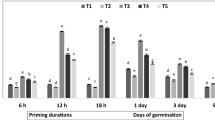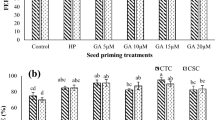Abstract
The delayed planting suppresses germination, growth and productivity of chickpea due to low temperature. Seed priming may improve the germination and growth of chickpea; however, no study has reported the effect of seed priming techniques on germination indices, growth and productivity of late-sown chickpea. This study was conducted to evaluate the influence of seed priming in improving performance of late sown chickpea. Chickpea seeds were subjected to on-farm priming, hydropriming and osmopriming (CaCl2). In experiment I, seeds of chickpea cultivars Punjab-2008 and Thal-2006 were sown in soil filled pots. Seed priming improved crop stand establishment and seedling dry weight owing to priming-induced improvement in sugars’ metabolism. In the second experiment, primed and untreated seeds of both chickpea cultivars were sown on Dec 03 and 18, and Jan 03 at Faisalabad and Multan, Pakistan during three growing seasons. Delay in planting decreased the germination indices, crop stand, growth and yield at both sites during all 3 years. Seed priming improved crop stand and growth of both chickpea cultivars resulting in increase in grain yield and net economic returns, and osmopriming was the most effective. Chickpea cultivars differed for yield and net economic returns and Punjab-2008 had better grain yield and economic returns compared to Thal-2006. Therefore, chickpea cultivar Punjab-2008 should be planted after osmopriming to harvest better yield and profitability from late sown chickpea.


Similar content being viewed by others
References
Bernfeld, P. (1955). Amylases α and β. In S. P. Cdowick & I. Kaplan (Eds.), Methods in enzymology (Vol. 1, pp. 149–158). New York: Academic Press.
Bewley, J. D., & Black, M. (1985). Seeds physiology of development and germination. New York: Plenum Press.
Burgass, R. W., & Powell, A. A. (1984). Evidence for repair processes in the invigoration of seeds by hydration. Annals of Applied Biology, 53, 753–757.
Bush, D. S. (1995). Calcium regulation in plant cells and its role in signalling. Annual Review of Plant Physiology and Plant Molecular Biology, 46, 95–122.
Dubois, M., Giles, K. A., Hamilton, J. K., Roberes, P. A., & Smith, F. (1956). Colorometric method for determination of sugars and related substances. Analytical Chemistry, 28, 350–356.
Ellis, R. A., & Roberts, E. H. (1981). The quantification of ageing and survival in orthodox seeds. Seed Science and Technology, 9, 373–409.
Farooq, M., Aziz, T., Wahid, A., Lee, D. J., & Siddique, K. H. M. (2009). Chilling tolerance in maize: Agronomic and physiological applications. Crop Pasture and Science, 60, 501–516.
Farooq, M., Basra, S. M. A., Hafeez, K., & Ahmad, N. (2005). Thermal hardening: A new seed vigor enhancement tool in rice. Journal of Integrative Plant Biology, 47, 87–93.
Farooq, M., Basra, S. M. A., Khalid, M., Tabassum, R., & Mehmood, T. (2006). Nutrient homeostasis, reserves metabolism and seedling vigor as affected by seed priming in coarse rice. Canadian Journal of Botany, 84, 1196–1202.
Farooq, M., Basra, S. M. A., Rehman, H., & Saleem, B. A. (2008). Seed priming enhances the performance of late sown wheat (Triticum aestivum L.) by improving the chilling tolerance. Journal of Agronomy and Crop Sciences, 194, 55–60.
Farooq, M., Hussain, M., Nawaz, A., Lee, D.-J., Alghamdi, S. S., & Siddique, K. H. M. (2017). Seed priming improves chilling tolerance in chickpea by modulating germination metabolism, trehalose accumulation and carbon assimilation. Plant Physiology and Biochemistry, 111, 274–283.
Harris, D., Raghuwanshi, B. S., Gangwar, J. S., Singh, S. C., Joshi, K. D., Rashid, A., et al. (2001). Participatory evaluation by farmers of on-farm seed priming in wheat in India, Nepal, and Pakistan. Experimental Agriculture, 37, 403–415.
Hunt, R. (1978). Plant growth analysis (pp. 26–38). London: Edward Arnold.
Hussain, M., Farooq, M., Shabir, G., Khan, M. B., & Zia, A. B. (2012). Delay in planting decreases wheat productivity. International Journal of Agriculture and Biology, 14, 533–539.
Jame, Y. W., & Cutforth, H. W. (2004). Simulating the effects of temperature and seeding depth on germination and emergence of spring wheat. Agricultural and Forest Meteorology, 124, 207–218.
Kaur, S., Gupta, A. K., & Kaur, N. (2005). Seed priming increases crop yield possibly by modulating enzymes of sucrose metabolism in chickpea. Journal of Agronomy and Crop Science, 191, 81–87.
Krishnamurthy, L., Johansen, C., & Sethi, S. C. (1999). Investigation of factors determining genotypic differences in seed yield of non-irrigated and irrigated chickpeas using a physiological model of yield determination. Journal of Agronomy and Crop Science, 183, 9–17.
Nawaz, A., Farooq, M., Ahmad, R., Basra, S. M. A., & Lal, R. (2016). Seed priming improves stand establishment and productivity of no till wheat grown after direct seeded aerobic and transplanted flooded rice. European Journal of Agronomy, 76, 130–137.
Saxena, N. P. (1984). Chickpea. In P. R. Goldsworthy & N. M. Fisher (Eds.), The physiology of tropical field crops (pp. 308–341). New York: Wiley.
Srinivasan, A., Johansen, C., & Saxena, N. P. (1998). Cold tolerance during early reproductive growth of chickpea (Cicer arietinum L.): Characterization of stress and genotypic variation in pod set. Field Crops Research, 57, 181–193.
Steel, R. G. D., Torrie, J. H., & Dicky, D. A. (1997). Principles and procedures of statistics: A biometrical approach (3rd ed., p. 666). New York: McGraw Hill Book Co. Inc.
Welbaum, G. E., & Bradford, K. J. (1991). Water relations of seed development and germination in muskmelon. VI. Influence of priming on germination responses to temperature and water potential during seed development. Journal of Experimental Botany, 42, 393–399.
Acknowledgements
The authors extend their appreciation to the International Scientific Partnership Program (ISPP) at King Saud University for funding this research work through ISPP# 0085.
Author information
Authors and Affiliations
Corresponding author
Ethics declarations
Conflict of interest
No potential conflict of interest was reported by the authors.
Rights and permissions
About this article
Cite this article
Farooq, M., Hussain, M., Imran, M. et al. Improving the Productivity and Profitability of Late Sown Chickpea by Seed Priming. Int. J. Plant Prod. 13, 129–139 (2019). https://doi.org/10.1007/s42106-019-00041-z
Received:
Accepted:
Published:
Issue Date:
DOI: https://doi.org/10.1007/s42106-019-00041-z




